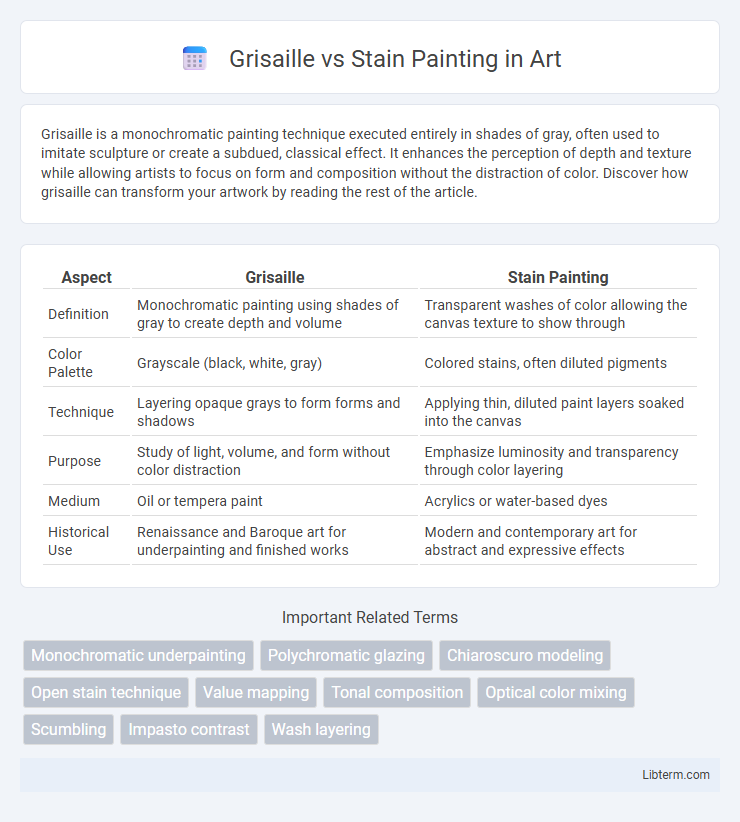Grisaille is a monochromatic painting technique executed entirely in shades of gray, often used to imitate sculpture or create a subdued, classical effect. It enhances the perception of depth and texture while allowing artists to focus on form and composition without the distraction of color. Discover how grisaille can transform your artwork by reading the rest of the article.
Table of Comparison
| Aspect | Grisaille | Stain Painting |
|---|---|---|
| Definition | Monochromatic painting using shades of gray to create depth and volume | Transparent washes of color allowing the canvas texture to show through |
| Color Palette | Grayscale (black, white, gray) | Colored stains, often diluted pigments |
| Technique | Layering opaque grays to form forms and shadows | Applying thin, diluted paint layers soaked into the canvas |
| Purpose | Study of light, volume, and form without color distraction | Emphasize luminosity and transparency through color layering |
| Medium | Oil or tempera paint | Acrylics or water-based dyes |
| Historical Use | Renaissance and Baroque art for underpainting and finished works | Modern and contemporary art for abstract and expressive effects |
Introduction to Grisaille and Stain Painting
Grisaille is a monochromatic painting technique executed entirely in shades of gray to create sculptural effects and emphasize form and volume. Stain painting involves applying diluted pigments that soak into the surface, producing luminous color layers that enhance depth and texture. Both techniques prioritize different visual dynamics: Grisaille highlights tonal values and structure, while stain painting focuses on color vibrancy and translucency.
Historical Background of Grisaille
Grisaille painting, originating in the Gothic period during the 12th century, was primarily used to imitate sculpture through monochromatic tones of gray. This technique gained prominence in medieval illuminated manuscripts and church stained glass windows, emphasizing form and light without color distraction. It laid a foundation for Renaissance artists to explore tonal modeling and depth before integrating full color palettes.
Origins and Evolution of Stain Painting
Stain painting emerged primarily in the mid-20th century as a technique central to the Abstract Expressionist movement, characterized by the application of diluted paint onto unprimed canvas to create luminous, fluid color fields. This method evolved from earlier glazing and wash techniques but distinguished itself through its emphasis on spontaneity and the integration of paint with the canvas surface, notably advanced by artists such as Helen Frankenthaler and Morris Louis. Unlike grisaille, which originates from medieval panel painting using monochromatic tones to simulate sculpture, stain painting represents a significant shift towards abstraction and color field painting in modern art history.
Key Techniques in Grisaille Art
Grisaille painting techniques center on using varying shades of gray to simulate sculptural reliefs and create a monochromatic, three-dimensional effect. Artists apply thin, translucent layers of paint to build depth and subtle tonal variations, emphasizing light and shadow to model form precisely. This method contrasts with stain painting, which relies on staining the canvas with transparent washes of color to achieve luminosity without heavy texture.
Core Methods in Stain Painting
Stain painting utilizes the method of thinning pigment with water or acrylic mediums to allow absorption into unprimed canvas, creating translucent, luminous color fields. Core techniques involve pouring, brushing, or soaking the diluted paint into the canvas fibers, emphasizing fluidity and spontaneity over thick texture. This absorbent approach contrasts with grisaille, which employs layered monochromatic tones for detailed, sculptural effects in opaque paints.
Materials Used in Grisaille vs Stain Painting
Grisaille painting primarily employs monochromatic pigments, often shades of gray, using oil or tempera mediums to create detailed, textured effects that mimic sculpture. Stain painting relies on thin washes of transparent or semi-transparent pigments diluted with water or oil to penetrate the surface, emphasizing luminosity and fluid color effects on canvas or paper. The choice of materials directly impacts the techniques: grisaille demands denser, opaque paints for layering and shading, while stain painting requires fluid, diluted pigments for seamless color transitions.
Artistic Effects and Visual Outcomes
Grisaille painting uses monochromatic shades of gray to create sculptural depth and a three-dimensional illusion, emphasizing form and volume with a muted palette. Stain painting employs translucent layers of color that soak into the canvas, producing vibrant, luminous effects with soft edges and fluid transitions. The artistic effect of grisaille conveys solidity and classical refinement, while stain painting achieves ethereal luminosity and emotional intensity through color saturation.
Prominent Artists in Grisaille and Stain Movements
Prominent artists in the grisaille painting technique include Andrea Mantegna, renowned for his intricate monochromatic frescoes, and Jan van Eyck, who utilized grisaille in detailed panel paintings to simulate sculpture. In the stain painting movement, Morris Louis and Helen Frankenthaler are key figures, celebrated for their innovative use of thinned paint poured directly onto unprimed canvas, creating vibrant, flowing color fields. These artists significantly shaped the visual language and techniques distinctive to each style, influencing subsequent generations of painters.
Contemporary Applications and Trends
Grisaille painting, characterized by monochromatic gray tones, remains popular in contemporary art for its ability to highlight form and structure, often used in underpainting and mural techniques. Stain painting, employing diluted pigments to create fluid, translucent layers, dominates abstract and modern art scenes, enabling dynamic color interactions and texture explorations. Recent trends show a fusion of both methods, allowing artists to combine Grisaille's detailed tonal groundwork with Stain's vibrant, expressive color washes for innovative visual effects.
Choosing Between Grisaille and Stain Painting
Choosing between grisaille and stain painting depends on the desired texture and tonal depth in the artwork. Grisaille, characterized by its monochromatic gray tones, offers precise control over light and shadow, making it ideal for detailed studies and underpaintings. Stain painting involves applying transparent layers of color that soak into the surface, creating luminous effects and richer color variations suited for vibrant, expressive compositions.
Grisaille Infographic

 libterm.com
libterm.com